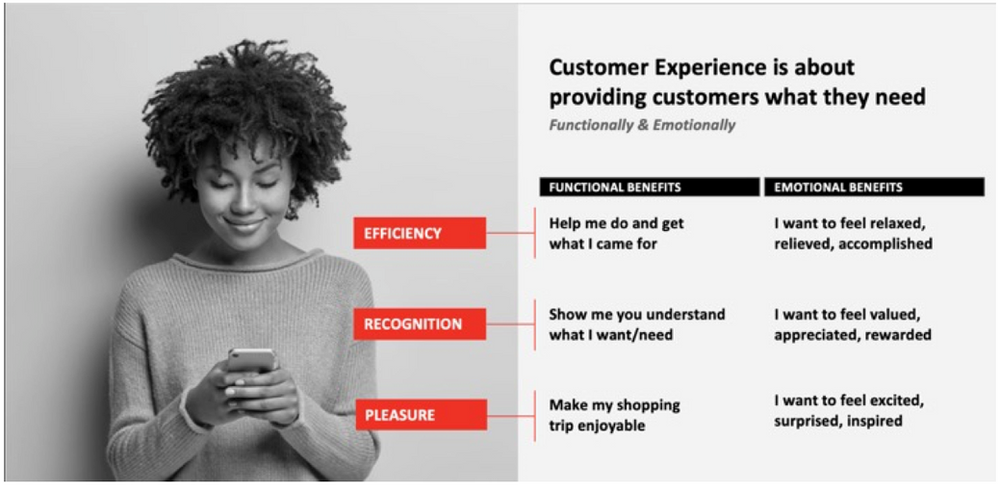An optimal retail customer experience must satisfy both the functional and emotional needs of shoppers.
By Katherine Barks, The Mars Agency

For shoppers today, retailer value extends beyond the ability to find and purchase products at a fair price. It’s now about being able to easily find and buy what they need, when and where they want to buy it, with minimal points of friction. As this definition of value continues to evolve, customer experience design must be a top priority for retailers who are trying to win repeat trips and long-term loyalty.
Now that shoppers can decide when and where to shop based on what works best for them in any given situation, retailers must be ready to deliver an exceptional experience at every possible engagement opportunity.
95% of purchase decisions are subconscious. (1)
Emotion is what really drives purchasing behaviors.
Therefore, a retailer’s customer experience design needs to be connected, consistent and seamless across the entire ecosystem and must meet both the functional and emotional needs of the shopper.
A critical step in designing a great customer experience involves profiling each of the retailer’s high-value customers, including a comprehensive journey mapping process. This can help retailers understand not only what their customers need, but also how they want to feel.

The cost of entry for a good experience includes the “fundamentals of speed, convenience, consistency, and friendliness of store associates,” according to a recent PWC study. (2) “The one big connector is human touch. That is, creating real connections by making technology feel more human and giving employees what they need to create better experiences. People are increasingly loyal to retailers, products, brands, and devices that consistently provide value with minimum friction or stress,” the study says.
Using our proprietary Marilyn®customer journey mapping process, we help retailer clients visualize all the potential paths that their customers can take to the point of purchase and beyond. That lets them identify and prioritize opportunities to further enhance or add points of engagement along the path, and helps them understand how every touchpoint can support and extend a positive experience — including the impact of store-level associates.
In fact, “due to recent changes in work patterns … the employee experience is becoming the new CX,” according to a recent article published by the Society for Human Resource Management. “[A retailer’s] employees are the most important asset they have to help serve today’s customers while adapting to tomorrow’s customer-satisfying processes and technologies,” the article states. “And providing staff with the right technology and equipment will go a long way toward attracting and keeping strong talent.” (3)
In the last few years, many retailers have focused on introducing new technology as a way to differentiate themselves and enhance the shopping experience. But introducing technology without defining its purpose within the experience — including how it enables store associates — can add complexity or friction rather than alleviating it. As part of our CX design process, we evaluate any technology the retailer is considering based on how it enables or enhances a frictionless, seamless experience for both shoppers and associates.
Another essential component of CX design is defining the role of the physical store and how it complements the online store experience. “The future of buying must include a proactive strategy for creating stores designed to win, serve and retain channel-agnostic, digital savvy consumers because the consumer of today is evaluating the in-store experience using the standards they have historically reserved for online experiences,” proposes Brendan Witcher, VP & Principal Analyst at Forrester Research. “Retailers must build purpose-designed physical locations that are structured to deliver meaningful improvements to customer experiences.”(4)
As customers move fluidly between online and brick & mortar, they expect consistency from one “store” to the other. When mapping a detailed customer journey, we help retailers determine the interdependency between the online and physical store experiences and how they can ensure customers get what they want and expect.
In a recent study entitled, “The Forces of Customer Experience,” Ipsos identified six functional and emotional customer needs that must be addressed as part of any CX design:
- Fair Treatment: Make sure customers feel there is a fair exchange in their relationship with you.
- Certainty: They need to believe that things are clear, transparent, and working as expected.
- Control: They should feel in control of the situation.
- Status: They need to feel valued, respected, and worthy of special treatment.
- Belonging; Give them a personal sense of belonging, and also show that you care about the greater good.
- Enjoyment: Make their lives easier, so they feel a sense of freedom. (5)
By using these six dimensions as a filter during the customer journey mapping process, we can help the retailer address any potential points of friction for its customers. And by developing a detailed customer profile that covers both functional and emotional needs while also identifying priority points of engagement, we help retailers design an enhanced, differentiated customer experience that will drive increased traffic, conversion and, over time, loyalty.
SOURCES:
1. “How Customers Think: Essential Insights into the Mind of the Market,” Gerald Zaltman (Harvard Business School Press, 2003). As reported by Inc.com
2. “Experience is Everything: Here’s How to Get It Right,” Tom Puthiyam, et al. (PWC, 2018)
3. “Is Employee Experience the New Customer Experience?” Drew Robb (SHRM.org, January 2022)
4. “The Future of the Digital Store,” Brendan Witcher and Scott Compton (Forrester Research, October 2021)
5. “The Forces of Customer Experience,” Jean-Francois Demais (Ipsos, May 2020)
_____________________

About the Author
Katherine Barks is VP-Strategy within the Retail Solutions team at The Mars Agency. She is a business strategist with 25+ years of diverse experience across the many facets of strategy, including consumer/shopper behavior research, channel and category insight, retail strategy, customer experience design, and measurement best practice. A highly regarded marketer in North America, she has worked with many tier-one CPG clients such as Kimberly-Clark, S.C. Johnson, Unilever, Diageo, Heineken, Pfizer, Pepsi, Campbell Soup Company and General Mills.
In her current role, Katherine is focused on supporting retail strategists and retailer clients including Walmart Canada, Big Y and Hudson’s Bay.